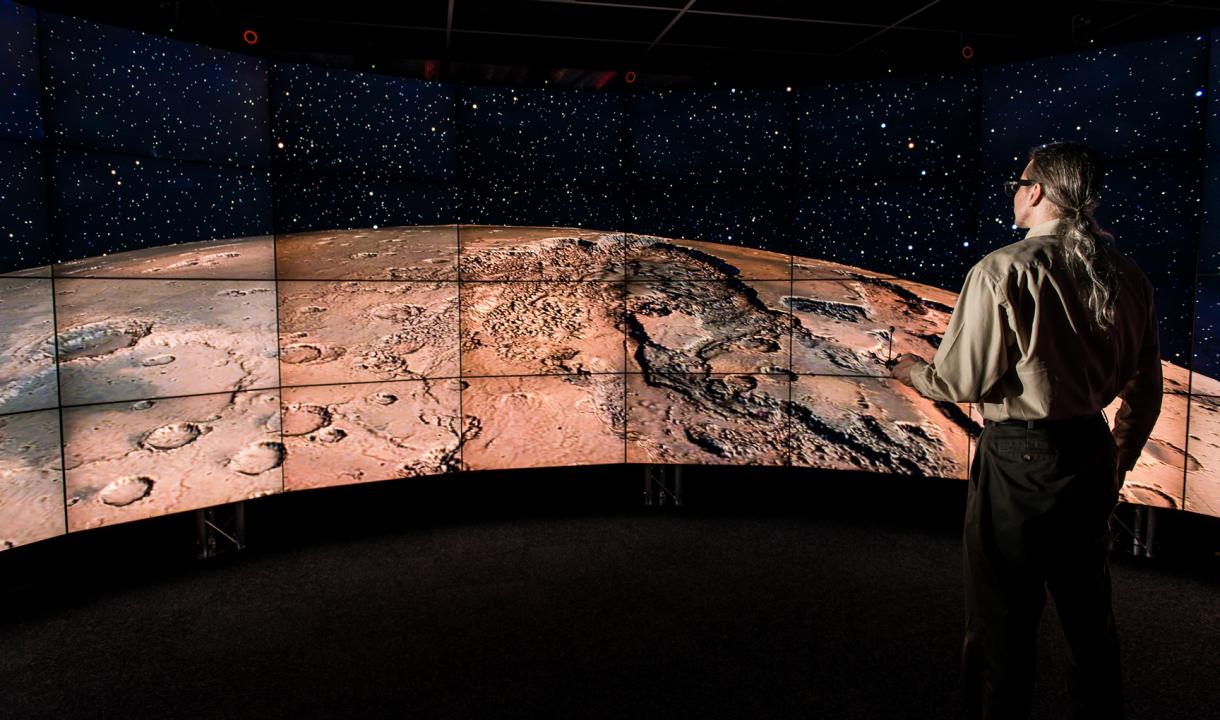|
|
||||||||||||||||||
Move over NASA: Explore the surface of Mars with virtual reality
Participants: Andrew Johnson, UIC Associate Professor; David Hofman, UIC Professor / Acting Head, UIC Physics Department; Mark SubbaRao, Astronomer / Director, Space Visualization Laboratory, Adler Planetarium
URL: http://news.medill.northwestern.edu/chicago/news.aspx?id=209741 Medill Reports Chicago The UIC Electronic Visualization Laboratory (EVL) CAVE2™ Virtual-Reality System is profiled in a recent news article by a Northwestern University Medill School journalism student. The article interviews computer science associate professor Andrew Johnson, who is one of the developers, as well as potential users - David Hofman, UIC Professor and Acting Head of the Physics department, and Mark SubbaRao, an astronomer and Director of the Space Visualization Laboratory at the Adler Planetarium. Below are excerpts from the article. Read the entire article Move over NASA: Explore the surface of Mars with virtual reality by Meghan Leach, Medill Reports Chicago October 30, 2012 Hop on the Magic School Bus to Egypt or Mars! But, in this case, hop into the magic CAVE2™ System, the Electronic Visualization Laboratory’s new virtual reality cocoon. Stand on the surface of Mars, explore ancient Egyptian ruins or squeeze inside a molecule all in a matter of minutes. CAVE2 uses the same 3D technology as 3D movies to put people in various settings - but the settings move with their gaze and gait. “Today so much of science is interdisciplinary and collaborative; we think this is the kind of tool that is going to be necessary for people to get a handle on all this data,” said Johnson. “It gives them a unique way to look at their data and interact with their data and be inside their data.” “I think a large part of pushing the frontiers of science and engineering is about finding the right way to look at things,” said David Hofman, a physicist at the University of Illinois at Chicago, which houses CAVE2 and the laboratory that created it. “CAVE2’s cutting edge 3D and fully immersive visualization will mean that instead of having to go to the moon, researchers will be able visit the Electronic Visualization Laboratory at UIC” for their ongoing research programs… Hofman also see the application of CAVE2 to education. “One of the challenges is to help students be able to visualize how a seemingly dry equation, such as Newton’s famous second law F=ma [Force = mass x acceleration], is actually alive and evident all around us at all times,” Hofman said. “The CAVE2 shows how we can do this. It is at the forefront of education and I, for one, am only just starting to grasp its true potential in explaining difficult subjects and making science come alive.” “There are couple of things about CAVE2 that make it the best immersive environment - just the incredible resolution and the brightness of the displays. The panorama of Egypt is so bright you feel like you’re outside in the day time,” said astronomer Mark SubbaRao of the Adler Planetarium… While discussing his experience with the panoptic mode, SubbaRao said, “If you’re the tracked person, if you duck down under a railing or you sit down, it moves with you, but how 3D things are doesn’t depend on the viewer. So that means the 3D is right for everybody. It provides the first-hand experience you get in a virtual reality environment, but you can have a group experience without making it uncomfortable.” Johnson got hooked on virtual reality programming because of the first CAVE, so he has high hopes for CAVE2. “I’m hoping that it inspires the current generation as much as I was inspired back then,” Johnson said. Email: maxine@uic.edu Date: October 30, 2012 |